Capturing the beauty of Kyoto’s temples requires skillful photography techniques to highlight their unique architecture and serene landscapes. Focus on composition, lighting, and perspective to enhance your images. Consider seasonal changes and cultural elements to enrich your narrative. Respectful engagement with the local customs will elevate your photographic experience.
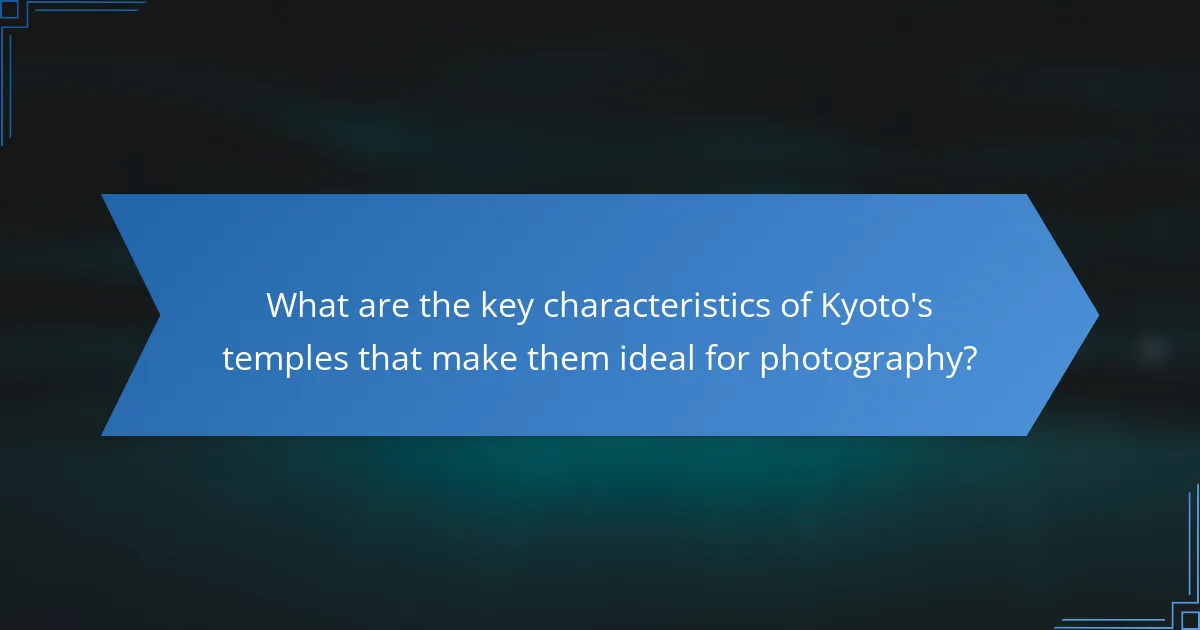
What are the key characteristics of Kyoto’s temples that make them ideal for photography?
Kyoto’s temples possess unique architectural styles, serene landscapes, and rich cultural history, making them ideal for photography. Their intricate designs, such as wooden structures and ornate decorations, provide stunning visual details. The surrounding natural beauty, including cherry blossoms and tranquil gardens, enhances the overall composition. The temples’ varying lighting conditions throughout the day create opportunities for dynamic shots. Seasonal changes also offer diverse photographic themes, from vibrant autumn foliage to serene winter scenes.
How does the architectural style of Kyoto’s temples influence photographic composition?
The architectural style of Kyoto’s temples significantly enhances photographic composition by providing unique visual elements. The intricate designs, vibrant colours, and harmonious integration with nature create compelling focal points. Photographers can leverage the symmetry and balance inherent in temple architecture to frame their shots effectively. Additionally, the seasonal changes in foliage around temples add dynamic backgrounds, enriching the overall aesthetic. Understanding these attributes enables photographers to capture the essence of Kyoto’s cultural heritage through thoughtful composition.
What cultural significance do Kyoto’s temples hold for photographers?
Kyoto’s temples offer rich cultural significance for photographers, showcasing Japan’s heritage and aesthetic beauty. These sites provide ideal backdrops for capturing traditional architecture, serene landscapes, and seasonal changes. The unique attributes of each temple, such as intricate designs and historical context, enhance the storytelling potential of photographs. Photographers can explore various techniques, like composition and lighting, to convey the spiritual essence of these locations.
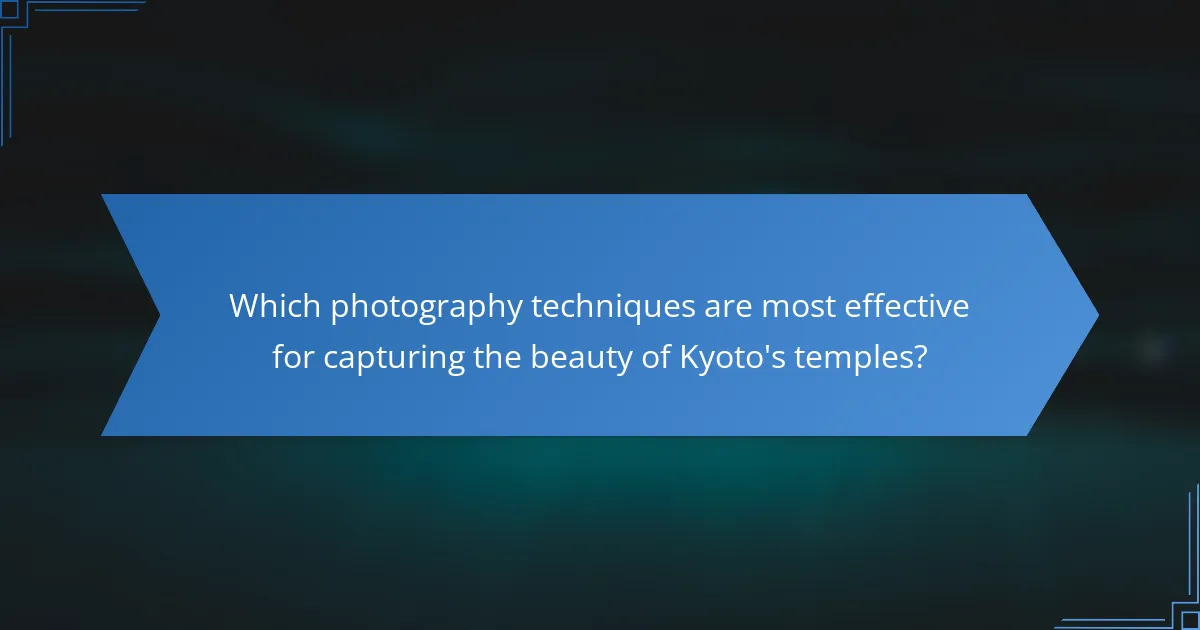
Which photography techniques are most effective for capturing the beauty of Kyoto’s temples?
To effectively capture the beauty of Kyoto’s temples, utilise techniques such as composition, lighting, and perspective.
Focus on leading lines to draw attention to architectural details. Early morning or late afternoon light enhances colours and shadows, creating depth. Experiment with different angles, including low and high perspectives, to showcase the temples’ grandeur. Use long exposure for capturing movement, like falling cherry blossoms, adding a dynamic element to still scenes.
Incorporate cultural elements, such as seasonal decorations, to enrich the narrative of your photographs. This approach highlights the unique attributes of each temple while conveying a sense of place and time.
How can lighting conditions enhance temple photography in Kyoto?
Lighting conditions can significantly enhance temple photography in Kyoto by creating mood and highlighting architectural details. Soft, diffused light during early morning or late afternoon accentuates textures and colours. For example, the golden hour casts warm tones, enriching the visual appeal of the temples. Additionally, overcast days provide even lighting, reducing harsh shadows and allowing for detailed captures of intricate carvings. Experimenting with different lighting can reveal unique perspectives, showcasing the cultural significance and beauty of Kyoto’s temples.
What role does seasonal change play in photographing Kyoto’s temples?
Seasonal change significantly enhances the photography of Kyoto’s temples by providing diverse backdrops and lighting conditions. Each season offers unique visual elements, such as cherry blossoms in spring and vibrant foliage in autumn. Photographers can capture the temples’ architectural beauty framed by these seasonal changes, creating striking compositions. Additionally, the varying light conditions throughout the year can dramatically alter the mood and atmosphere of the images, making each visit a fresh experience.
Which camera settings are recommended for temple photography in Kyoto?
For temple photography in Kyoto, use a wide aperture (f/2.8 to f/5.6) for depth of field and a low ISO (100-400) to minimise noise. Set a shutter speed of at least 1/125 seconds to capture movement without blur. Use a tripod for stability in low light.
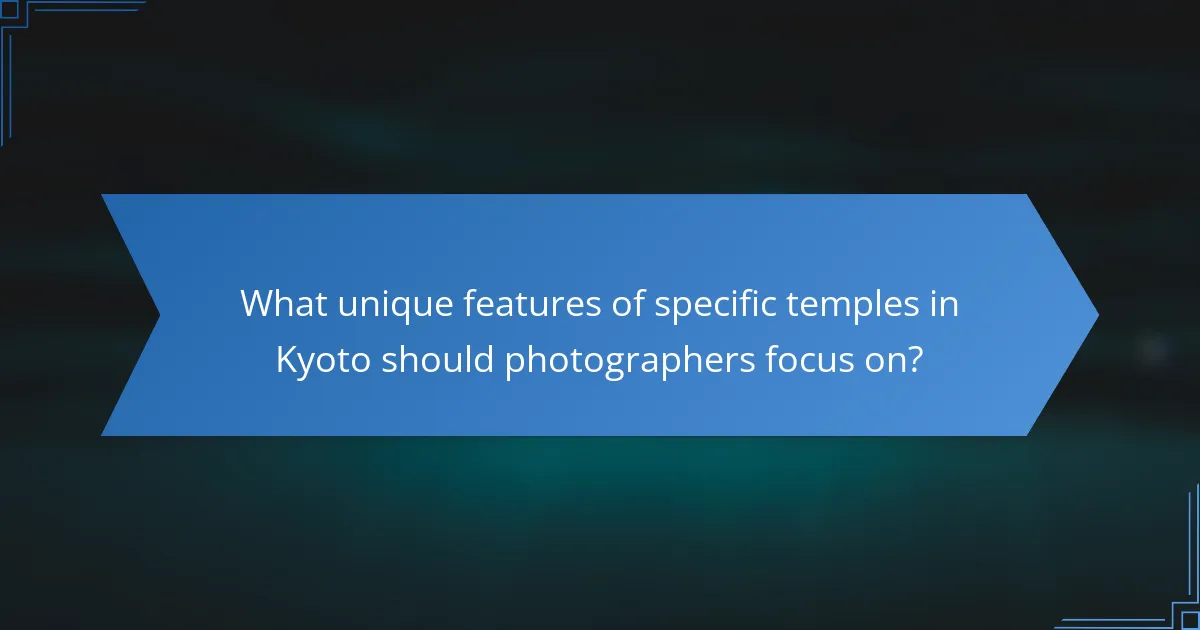
What unique features of specific temples in Kyoto should photographers focus on?
Photographers should focus on the distinct architectural styles, seasonal beauty, and cultural significance of Kyoto’s temples. Unique features include Kinkaku-ji’s gold leaf exterior, Ginkaku-ji’s serene gardens, and the intricate wooden structures of Kiyomizu-dera. Capturing these elements in varying light conditions enhances the visual narrative. The rare cherry blossoms at Nanzen-ji and vibrant autumn foliage at Eikando offer seasonal highlights. Each temple presents unique angles and perspectives, making them ideal subjects for exploration and photography.
Which temples offer distinctive landscapes that enhance photography?
Kyoto’s temples offer distinctive landscapes that enhance photography, including Kinkaku-ji, Ginkaku-ji, and Fushimi Inari Taisha. Kinkaku-ji features a golden pavilion surrounded by serene gardens, ideal for reflective shots. Ginkaku-ji showcases a moss garden and a unique sand mound, providing texture and depth. Fushimi Inari Taisha, with its iconic torii gates, creates a striking visual path through lush greenery. Each location presents unique lighting and seasonal changes, enriching the photographic experience.
How do historical elements of certain temples add depth to photographs?
Historical elements of Kyoto’s temples enhance photographs by providing rich context and storytelling. Features such as architectural styles, intricate carvings, and seasonal changes create compelling visual narratives. For example, the contrast between ancient stone and vibrant foliage adds depth. Capturing these elements invites viewers to appreciate the cultural significance and history behind each temple. The unique attributes of each site, such as their age and design, further enrich the photographic experience.
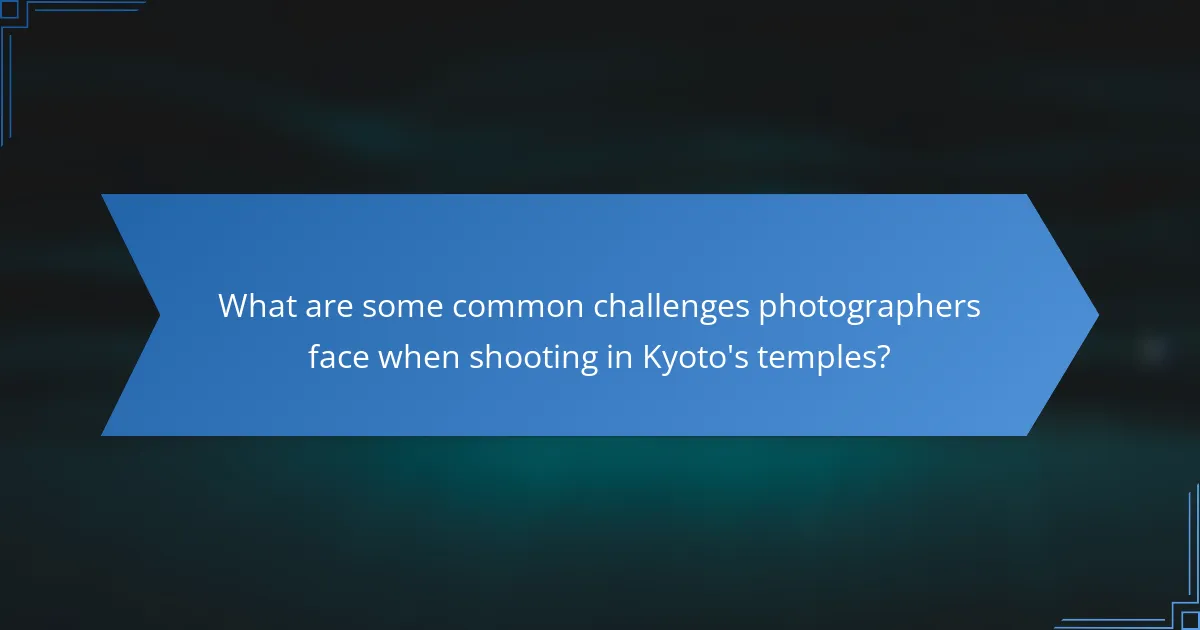
What are some common challenges photographers face when shooting in Kyoto’s temples?
Photographers face challenges like crowded spaces, changing light conditions, and cultural sensitivity when shooting in Kyoto’s temples. Crowds can obstruct views and hinder compositions. Light varies throughout the day, affecting exposure and mood. Cultural sensitivity is crucial, as some areas may have restrictions on photography.
How can crowds affect temple photography and what strategies can mitigate this?
Crowds can significantly hinder temple photography by obstructing views and creating distractions. Strategies to mitigate this include visiting during off-peak hours, using wide-angle lenses to capture more of the scene, and incorporating people into compositions for a dynamic perspective.
What are the limitations of natural light in temple photography?
Natural light in temple photography can limit the quality and detail of images. Variability in weather affects illumination, leading to harsh shadows or overexposed highlights. During midday, light can be too intense, washing out colours and textures. Early morning or late afternoon provides softer light but may restrict shooting times. Additionally, natural light can create challenges in capturing intricate details of temple architecture due to contrast issues.
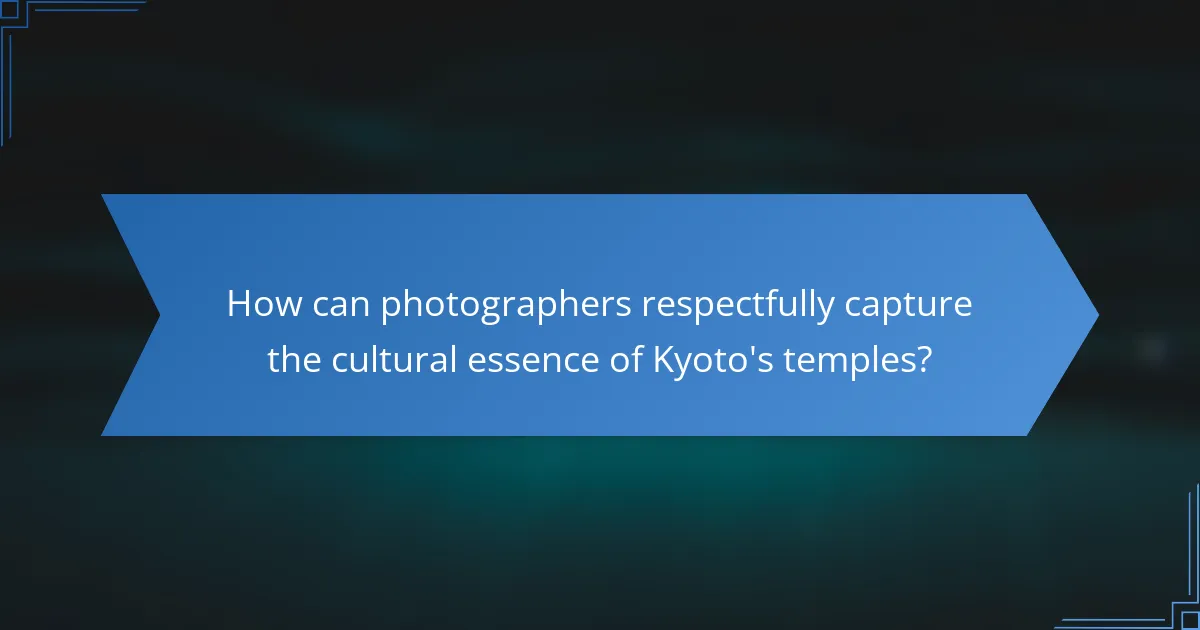
How can photographers respectfully capture the cultural essence of Kyoto’s temples?
Photographers can respectfully capture the cultural essence of Kyoto’s temples by focusing on authenticity, context, and sensitivity. Engaging with local customs enhances the storytelling aspect of photography.
Utilise natural light during early mornings or late afternoons to highlight architectural details and serene landscapes. This approach respects the tranquil atmosphere of the temples and their surroundings.
Incorporate elements of local culture, such as seasonal festivals or traditional ceremonies, to provide depth to the images. This practice showcases the unique attributes of each temple, enhancing the narrative.
Lastly, always seek permission when photographing individuals or sacred ceremonies. This respect fosters positive relationships with the community and enriches the photographic experience.
What etiquette should be observed while photographing in Kyoto’s temples?
Respectful etiquette is essential when photographing in Kyoto’s temples. Always seek permission before taking photos, especially of people or ceremonies. Maintain silence and avoid disruptive behaviour to preserve the serene atmosphere. Use natural light to capture the beauty of the architecture and surroundings, and be mindful of your surroundings to avoid obstructing pathways. Lastly, refrain from using flash, as it can be distracting and disrespectful in sacred spaces.
How can photographers incorporate local customs into their photographic narrative?
Photographers can incorporate local customs into their narrative by engaging with cultural practices and rituals. Observing traditional ceremonies at Kyoto’s temples enhances storytelling through visuals. Capturing elements like attire, offerings, and architecture provides context. Additionally, interacting with locals fosters authentic connections, enriching the photographic experience. Emphasising seasonal events, such as cherry blossom festivals, highlights unique cultural expressions, making the narrative more compelling.

What are the best practices for editing temple photographs to enhance their impact?
To enhance the impact of temple photographs, focus on composition, lighting, and post-processing techniques. Use the rule of thirds to create balanced images, ensuring key elements are positioned effectively. Capture images during golden hour for soft, warm light that accentuates architectural details. In post-processing, adjust contrast and saturation to bring out vibrant colours while preserving the temple’s authenticity. Lastly, consider using filters to create a unique atmosphere that reflects the cultural significance of Kyoto’s temples.
Which editing techniques can bring out the architectural details of Kyoto’s temples?
To highlight the architectural details of Kyoto’s temples, use techniques like close-up shots, natural lighting, and composition framing. These methods enhance intricate designs and cultural significance.
Utilise close-up photography to capture unique attributes, such as carvings and textures. Natural lighting, especially during golden hour, accentuates colours and shadows, revealing depth. Composition techniques, like leading lines and symmetry, draw attention to temple structures and their surroundings.
How can colour grading enhance the mood of temple photography?
Colour grading significantly enhances the mood of temple photography by altering the emotional tone and visual impact. Different colour palettes evoke specific feelings; warm tones can create a sense of tranquility, while cooler tones may convey serenity or introspection.
For example, using rich oranges and yellows can highlight the warmth of Kyoto’s temples during sunset, enriching the cultural experience. Conversely, cooler blues and greens can emphasise the peacefulness of a temple’s surroundings, inviting contemplation.
By adjusting contrast and saturation, photographers can further accentuate architectural details, drawing attention to unique attributes of the temples. This technique transforms the viewer’s perception, making the photographs not just images but emotional experiences.
What common mistakes should photographers avoid when editing temple images?
Photographers should avoid over-editing, neglecting composition, and ignoring cultural context when editing temple images. Over-editing can lead to unnatural colours and loss of detail. Maintaining composition is crucial for capturing the beauty of the temples. Ignoring cultural context may result in images that do not respect the significance of the sites.
What expert tips can improve the overall quality of temple photography?
To improve the overall quality of temple photography in Kyoto, focus on composition, lighting, and cultural context. Use leading lines to draw attention to temple features, capture early morning or late afternoon light for softer shadows, and research the cultural significance of each temple to enhance storytelling through your images. Experiment with different angles and perspectives to showcase the architectural beauty and surrounding landscapes.